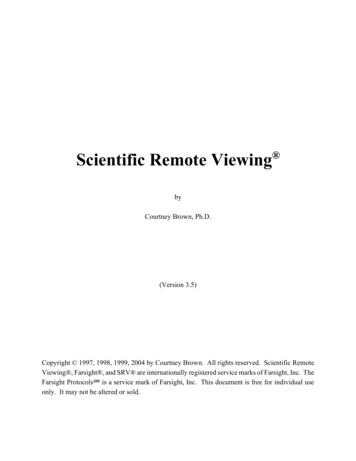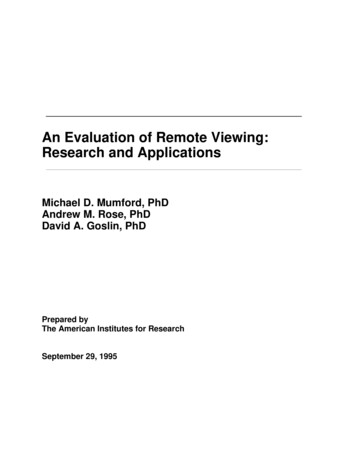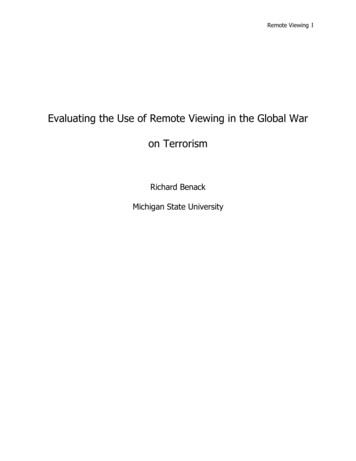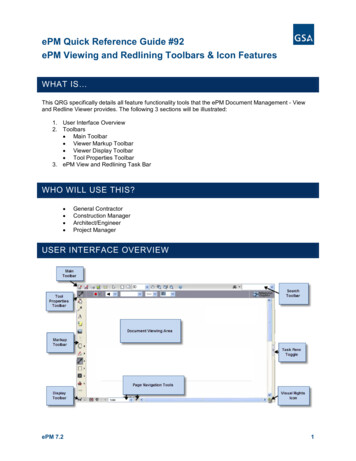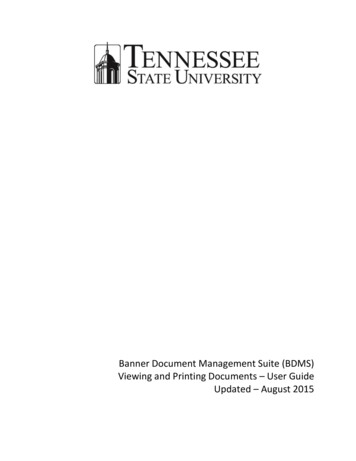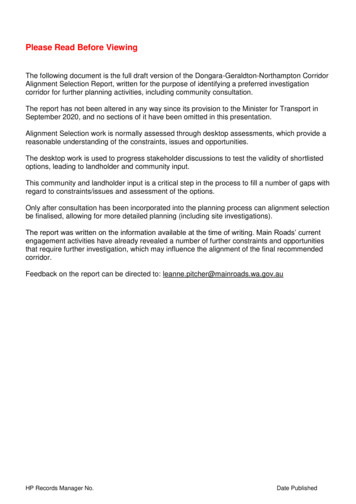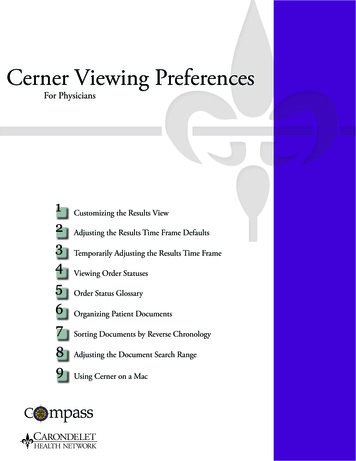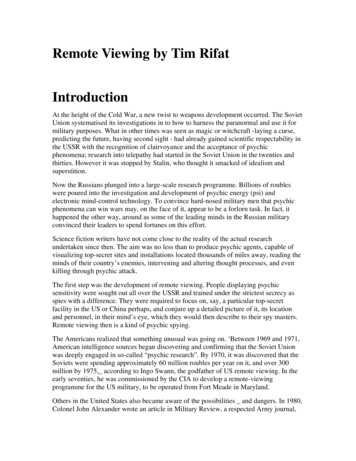
Transcription
Remote Viewing by Tim RifatIntroductionAt the height of the Cold War, a new twist to weapons development occurred. The SovietUnion systematised its investigations in to how to harness the paranormal and use it formilitary purposes. What in other times was seen as magic or witchcraft -laying a curse,predicting the future, having second sight - had already gained scientific respectability inthe USSR with the recognition of clairvoyance and the acceptance of psychicphenomena; research into telepathy had started in the Soviet Union in the twenties andthirties. However it was stopped by Stalin, who thought it smacked of idealism andsuperstition.Now the Russians plunged into a large-scale research programme. Billions of roubleswere poured into the investigation and development of psychic energy (psi) andelectronic mind-control technology. To convince hard-nosed military men that psychicphenomena can win wars may, on the face of it, appear to be a forlorn task. In fact, ithappened the other way, around as some of the leading minds in the Russian militaryconvinced their leaders to spend fortunes on this effort.Science fiction writers have not come close to the reality of the actual researchundertaken since then. The aim was no less than to produce psychic agents, capable ofvisualizing top-secret sites and installations located thousands of miles away, reading theminds of their country’s enemies, intervening and altering thought processes, and evenkilling through psychic attack.The first step was the development of remote viewing. People displaying psychicsensitivity were sought out all over the USSR and trained under the strictest secrecy asspies with a difference. They were required to focus on, say, a particular top-secretfacility in the US or China perhaps, and conjure up a detailed picture of it, its locationand personnel, in their mind’s eye, which they would then describe to their spy masters.Remote viewing then is a kind of psychic spying.The Americans realized that something unusual was going on. ‘Between 1969 and 1971,American intelligence sources began discovering and confirming that the Soviet Unionwas deeply engaged in so-called “psychic research”. By 1970, it was discovered that theSoviets were spending approximately 60 million roubles per year on it, and over 300million by 1975, according to Ingo Swann, the godfather of US remote viewing. In theearly seventies, he was commissioned by the CIA to develop a remote-viewingprogramme for the US military, to be operated from Fort Meade in Maryland.Others in the United States also became aware of the possibilities and dangers. In 1980,Colonel John Alexander wrote an article in Military Review, a respected Army journal,
entitled ‘The New Mental Battlefield’. The article described remote viewing andsuggested that effective mind-influencing devices were already a ‘lethal’ reality. The USArmy’s partly classified ‘Fire Support Mission Area Analysis’ of 1981 talked about‘cryptomental technologies’ and ‘the relatively unexplored, unexploited humantechnologies in such areas as influence, communications, thinking, learning, and stressreduction. Discussions in this area represent an excursion into a largely unknown realmwhich appears to possess significant military application.’Progress from that time has been rapid with the development of sophisticated techniquesand technology, until today, as this book will show, psychotronic, i.e. mind-control,weapons are the most top-secret class of weapons used not only by the Russians andAmericans, but increasingly by the Chinese, Japanese, British, Czechs and Israelis.It may be hard to believe that the Soviet Union and the United States could actuallyexplore the paranormal in search of new military technology for decades in almostabsolute secrecy, but the power and mastery to be attained by controlling the minds andwills of their perceived enemies was the spur. As long ago as 1975, when LeonidBrezhnev urged the US to agree to ban research into and development of new kinds ofweapons ‘more terrible’ than anything the world has known (reported in the New YorkTimes, June 1977), he was warning America that the USSR had the knowledge to end theCold War by psychic means.The first popular reports of this research appeared in 1970 in a book entitled PsychicDiscoveries Behind the Iron Curtain by Sheila Ostrander and Lynn Schroeder. MartinEbon’s 1983 book Psychic Warfare: Threat or Illusion? took the subject of psi warfaremuch further; and David Morehouse’s Psychic Warrior: Inside the CIA’s StargateProgram (1996) tells an insider’s story. Major Morehouse had been one of the USmilitary’s top remote viewers and the US military are allegedly unhappy at hisrevelations.Apart from the books, a few stories have filtered out into the public domain. For instance,the Associated Wire Press ran a story on 28 November 1995 under the headline ‘US used“psychic” spies’:For 20 years, the United States has secretly used psychics in attempts to hunt downLibyan leader Muammar Quaddafi, find plutonium in North Korea and help drugenforcement agencies, the CIA and others confirmed Tuesday.The London Daily Express published an article on 25 September 1997 under the headline‘Reds planned psycho-wars’:The KGB and the Red Army carried out experiments aimed at using hypnotic warfareagainst the West, it emerged yesterday. Revelations include a prototype satellite releasingelectronic mind-bending signals to ‘control and correct the behaviour of the population’over an area the size of England. Research into psycho-warfare was conducted in morethan twenty institutes led by the Siberian scientific community of Novosibirsk, and onlystopped in 1991. However fears were voiced yesterday that the technology could fall intothe hands of the powerful Russian Mafia. The research was disclosed by the Izvestia
newspaper under the headline ‘They Could Produce Zombies in the USSR’. It is clearlarge-scale experiments were carried out on ordinary Russians and soldiers.However, under the US Freedom of Information Act, previously unpublished files fromthe US Department of Defense Intelligence Agency (DIA) have now become available,which detail Soviet research in this area and add weight to the assertions made in thebooks, as well as giving credibility to the other stories. The documents given inAppendices 1 and 2 together provide the definitive work on Soviet psychical research upuntil 1975. They show the importance accorded the Soviet Union’s advances in psychicspying and mind-control techniques by the United States authorities, and thecountermeasures taken and parallel progress made.I found all this hard to swallow when I first learnt of it but my research into the scientificbasis of the biophysical technology convinced me that the Russians had entered into newterritories. They had begun the inner-space arms race, which they developed toundreamed of levels of power. After nuclear warfare, biophysical warfare is the secondgreat cross-roads for human civilization. Inner-space weapon systems had, and have, thepotential to kill, or even to drive mad entire populations by means of biophysical andelectronic technology unknown to the West in the 1970s.Whether or not you believe in remote viewing and the psychotronic weapons described inthis book, by the end of the first part you will know that the US and Soviet militaryauthorities believed in them.During my research, I have become aware of how useful remote viewing can be ingaining information on topics that have proved impossible to analyse by any othermethod. Having developed basic do-it-yourself guides for beginners, I found that withthese simple methods accuracy could be a problem. The new methodology outlined in thesecond part of this book will help people who want to practise controlled remote viewingas espoused by the Americans, as well as teaching a Russian-like version of extendedremote viewing.1 How it all started - in RussiaScientists in pre-Revolutionary [Russia] were studying the area of parapsychology as didlater such Soviet scientists as V.M. Bekhterev, A.G. Ivanov-Smolensky and B.B.Kazhinsky in the twenties and thirties. In 1922, a commission composed ofpsychologists, medical hypnotists, physiologists, and physicists worked onparapsychology problems at the Institute for Brain Research in Petrograd (Leningrad).Work flourished throughout the thirties with research being reported in the literature in1934, 1936, and 1937. After 1937 further experiments in the field of parapsychologywere forbidden. During Stalin’s time, any attempt to study paranormal phenomena mighthave been interpreted as a deliberate attempt to undermine the doctrines of materialism.So stated the 1972 DIA report ‘Controlled Offensive Behavior - USSR’ (Appendix 1,page 22).The Defence Intelligence Agency are the military intelligence agency of the US
Department of Defence. Part of the military, mainly army, they carry out intelligencework for the Pentagon. According to an official CIA paper written by Gerald K. Haines,the historian of the National Reconnaissance Office (NRO): ‘There is a DIA PsychicCenter and the NSA (National Security Agency) studies parapsychology, that branch ofpsychology that deals with the investigation of such psychic phenomena as clairvoyance,extrasensory perception, and telepathy.In 1960 the Stalinist taboo that prohibited research into the paranormal was lifted and theKGB and GRU (Soviet military intelligence) began a scientific exploration of theweapons potential of psychic energy.Soviet interest in psi was reawakened in February 1960 by a story which appeared inFrench magazine Science et Vie (Science and Life). The story was entitled ‘The Secretsof the Nautilus’ and it claimed that the US government had secretly used telepaths tocommunicate with the first nuclear submarine ever constructed, the Nautilus, while it wasunder the Arctic ice pack. This telepathy project involved, according to the article,President Eisenhower, the Navy, the Air Force, Westinghouse, General Electric, BellLaboratories and the Rand Corporation. Communicating with submarines is difficult asradio waves do not penetrate to the depths of the ocean. Extremely low frequency (ELF)waves are used to signal the submarine to come to the surface to receive a message these super-long waves penetrate almost anything including water but carry littleinformation - so if telepathy could work it would be a perfect method of communicatingwith submarines while still submerged. The story was almost certainly a hoax but theSoviets were spurred into action, according to the DIA:Ship-to-shore telepathy, according to the French, blipped along nicely even when theNautilus was far under water. ‘Is telepathy a new secret weapon? Will ESP be thedeciding factor in future warfare? Has the American military learned the secrets of mindpower?’ In Leningrad the Nautilus reports went off like a depth charge in the mind ofL.L. Vasilev. In April of 1960, Doctor Vasilev, while addressing a group of top Sovietscientists stated: “We carried out extensive and until now completely unreportedinvestigations under the Stalin regime. Today the American Navy is testing telepathy ontheir atomic submarines. Soviet scientists conducted a great many successful telepathytests over a quarter of a century ago. It's urgent that we throw off our prejudices. We mustagain plunge into the exploration of this vital field.” [Appendix 1, page 24.]From 1922 to 1959, this [negative] attitude [to parapsychology] gradually changed.Official recognition of parapsychology as a legitimate science was prompted to aconsiderable extent by the Party's recognition of other discipline. In 1959 Professor L.L.Vasilev published his “Mysterious Phenomena of the Human Psyche” followed in 1962by his “Experiments in Mental Suggestion”.the possible military implications wereapparently overlooked in the West. [Appendix 2, page 15.]Groups of scientists at many Soviet research institutes began to investigate and laterharness psychic energy. The aim of this research was to produce deadly new weaponsthat could tip the balance of power during the Cold War. The DIA again:Soviet parapsychology research gained impetus and sophistication, growing from a single
laboratory into a co-ordinated USSR-wide effort; laboratories were also established inCzechoslovakia. Funds for research (reported at 20 million roubles in 1973) are believedto be primarily from military sources. This high level of support advanced Sovietresearch on human telepathy far beyond that of the West, and the USSR became theleader in sponsoring and participating in international parapsychology symposiums.[Appendix 2, page 15] .by 1968 the Soviets already had: (1) established several researchcenters specializing in telepathic experiments on an academic and scientific level; (2)organized teams of scientists - physiologists, physicists, psychologists, mathematicians,cyberneticians, neurologists, and electronic engineers to investigate telepathy, find outhow it works, and devise means of practical application; and (3) conducted experimentsinvolving long-range thought transference (Leningrad-Moscow (600km); MoscowTomsk (4000km). [Appendix2, page 18.].Professor Vasilev was given state funds to establish at the University appropriatelyequipped laboratories for the study of telepathy. Following the example of Leningrad,other cities, including Moscow, Kiev, Novosibirsk and Kharkov, established similarlaboratories and research centers, at which not only the phenomena described in worldliterature were examined, but a study was made of parapsychic features displayed bySoviet citizens. [Appendix 1, page 23.]Although the US Navy subsequently denied the reports of telepathic testing on atomicsubmarines, the Soviet hierarchy apparently heeded Doctor Vasilev's advice and gavesupport, both moral and financial, to his dynamic view that:“The discovery of the energy underlying telepathic communicatio
The first popular reports of this research appeared in 1970 in a book entitled Psychic Discoveries Behind the Iron Curtain by Sheila Ostrander and Lynn Schroeder. Martin Ebon’s 1983 book Psychic Warfare: Threat or Illusion? took the subject of psi warfare much further; and David Morehouse’s Psychic Warrior: Inside the CIA’s StargateFile Size: 303KBPage Count: 84
